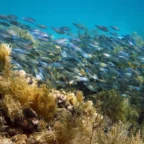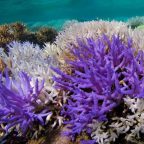
On World Oceans Day, June 8, the Government of Canada announced the establishment of the Eastern Canyons Marine Refuge, an area of 43,976 square kilometres (about 17,000 square miles) off the coast of Nova Scotia. This region, which stretches out to Canada’s exclusive economic zone (EEZ), includes both deep-sea canyons and abyssal plain, and will now be protected from bottom-contact fishing—including trawling, traps, and longlines—under Canada’s Fisheries Act. The act safeguards the nation’s fish and fish habitats and is an example of how tools other than marine protected areas (MPAs) can be used to conserve marine habitat.
Dr. Susanna Fuller, vice president for operations and projects for Oceans North, a Canadian nonprofit that focuses on marine conservation in the Arctic and Atlantic Canada, served on the technical advisory committee that helped develop the final plan for the refuge. This interview has been edited for length and clarity.
Q: First of all, what makes this ocean area unique in Atlantic Canada?

A: The new refuge includes a section of the continental shelf edge that has underwater canyons, which are home to deep-water corals and sponges and are feeding areas for whales and other marine mammals. Protecting this area fills an important gap in canyon protections in the Northwest Atlantic, because most areas with high concentrations of corals have been closed to bottom fishing—from the coast of New England out to the Grand Banks and Flemish Cap, and up to Baffin Bay in the Eastern Arctic.
Q: Can you say more about some of the species that will be protected?
A: The new refuge encompasses a current small closure that has protected the only known concentration of Lophelia pertusa—a reef-forming coral—on the Scotian Shelf. Coral in that small area is already recovering from past damage by fishing, so it’s exciting to have more coral habitat protected for restoration as well as undisturbed habitats. We also hope that this area will provide some insurance for future fisheries, since species such as halibut and redfish use corals and canyons for shelter and habitat.
Q: Designations such as this don’t happen overnight. How did this one get from concept to announcement?
A: This area was first formally identified by Fisheries and Oceans Canada (DFO) in 2018 as a potential fisheries closure to protect vulnerable habitats. DFO then began discussing potential protection measures and established a technical advisory group in 2020 to start working through boundaries, coral habitat, fishing displacement, and other concerns. A lot of work went into accommodating existing fishing interests, particularly the halibut longline fleet.
Q: So how were the boundaries decided?
A: Every inch of the boundary along the shelf edge was reviewed by all stakeholders on the advisory group—scientists and industry representatives—who focused on ensuring maximum conservation value, while also accounting for specific fishing concerns. There was a lot of discussion around the science as we compared data collected during field studies on the location of vulnerable habitats to what the models showed. It’s always hard to lose fishing ground, and while bottom longlines aren’t the most damaging gear type, they do impact deep-sea corals. Efforts were made, by the advisory group and ultimately by DFO, to ensure that some fishing communities were not more impacted than others. Although the process did not require complete agreement among all advisory group members, active participation by stakeholders ensured that all positions were heard. It was a respectful process, and DFO did a good job of keeping everyone accountable, sharing meeting notes, documenting decisions taken, and following up one-on-one with fishermen.
Q: How will this refuge help Canada meet its short-term goal of protecting 25% of its ocean territory by 2025?
A: This area is 0.76% of Canada’s marine area and stretches from the shelf break—where the edge of the continental shelf drops off toward the deep ocean—out 200 miles (320 kilometres) from the coast. That’s a big contribution toward protecting 25% by 2025. Canada is still in the early days of protected areas; the country had less than 1% of its marine and coastal environment protected in 2015, and it now stands at around 14.5%. So we really haven’t had that many years of understanding what works best for people and species. But at least we’re on the learning trajectory.
Q: How has Canada used marine protected areas and other approaches to effectively protect its marine environments?
A: Canada has used “other effective area-based conservation measures” (OECMs) to meet its conservation targets. Domestically, the Fisheries Act can be employed to close large areas to bottom fishing, such as in this new Eastern Canyons Marine Refuge. These fisheries management measures can be done more quickly and less expensively than marine protected areas that fall under other laws, such as Canada’s Oceans Act or the National Marine Conservation Areas Act. Internationally, Canada is a party to the United Nations Convention on Biological Diversity, a treaty designed to support and accelerate the conservation of biodiversity. Canada regularly aligns its OECM and MPA guidance with the Convention’s criteria for these tools so that Canada’s marine protections meet international standards.
Q: Can OECMs be a model elsewhere in Canada and globally?
A: They can work well in countries with a well-funded and effective fisheries management regime, and in places where the fishing industry is involved in creating the closures—and thus has accountability for ensuring that the boundaries are respected. Ultimately, if the threats are removed, biodiversity is being protected, and enforcement and compliance are effective, these fisheries management tools can be good ones. However, in areas closer to shore where there are coastal communities and more marine uses and interests in the coast, more comprehensive tools like MPAs are needed to allow for participatory governance.
Q: What else does the Government of Canada need to do to ensure that the ocean ecosystems of Atlantic Canada continue to thrive into the future and achieve Canada’s long-term goal to protect 30% of its ocean territory by 2030?
A: A lot of progress in protecting areas has been made in Atlantic Canada over the past decade. However, most of the areas currently protected are in offshore environments. As we move to more coastal areas, the process will get more difficult. There is an ongoing need to work closely with Indigenous and coastal communities to ensure that their concerns are heard and that they are involved in the establishment and management of marine protections over the long term. Fishermen, both Indigenous and non-Indigenous, are often the most knowledgeable people about the area where they make their livelihoods; without their support and assistance with monitoring and enforcement, near-shore protected areas won’t work.
Sometimes we forget that we still eat wild protein from the ocean, and for this to continue into the future, a healthy marine environment is foundational. We are not currently in balance with allowing nature to recover, as we have been exploiting nature for food and livelihoods, but we do know that the ocean has incredible resiliency. Protecting places and limiting industrial activities will be critical to enabling future ocean resiliency.















Social Profiles